Image copyright
Historic England/Alan Bull
The Philharmonic in Liverpool was built between 1898 and 1900
An opulent pub once praised by Bill Bryson for its ornate toilets has been given the same listed status as Buckingham Palace and Chatsworth House.
The Philharmonic Dining Rooms in Liverpool is the first purpose-built Victorian pub in England to be given Grade I status, Historic England said.
Ten other pubs have also had their status updated to include their interiors.
They include four of eight in the country known to have no actual bar.
 Image copyright
Image copyright
Historic England/Alan Bull
The Philharmonic in Liverpool is known for its ornate interior
Historic England said the Philharmonic as regarded as a “cathedral among pubs” for its grandeur, and was “one of the most spectacular pubs to be completed in the golden age of pub building” at the end of the 19th Century.
It was constructed between 1898 and 1900 by architect Walter W Thomas and was Grade II* listed in 1966.
Bill Bryson wrote about it in his 1995 book Notes From A Small Island saying: “There is no place in the world finer for a pee than the ornate gents’ room of the Philharmonic.”
Former Beatles star Sir Paul McCartney played a surprise show at the pub in 2018 while he was recording an episode of Carpool Karaoke with James Corden.
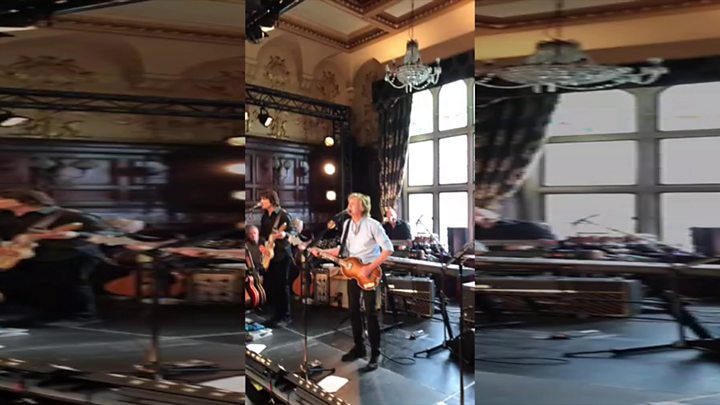
Media playback is unsupported on your device
It now joins the 2.5% of protected historic buildings to have the highest grade, a list that also includes Liverpool’s Anglican cathedral as well as Buckingham Palace and Chatsworth.
Two other Liverpool pubs have also been reassessed to have their interiors included in their listed status.
The Grade II* Vines on Lime Street was built in 1907 and retains original Edwardian features including a large stained glass dome and “a number of striking fireplaces”, while Grade II Peter Kavanagh’s on Egerton Street has carved corbels (wall brackets) thought to be caricatures of the pub’s regulars and original tables featuring spilt drink channels and in-built ash trays.
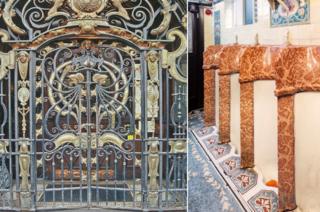 Image copyright
Image copyright
Historic England/Michael Slaughter/Alan Bull
The Philharmonic has ornate gates and toilets
 Image copyright
Image copyright
Michael Slaughter
The Vines has had its status updated to include its interiors
Elsewhere in the country, the Grade II Blue Ship, in Billingshurst in West Sussex, was built as a cottage in the 16th Century and converted into a pub in the 1850s.
It is one of only eight pubs known to have no bar counter and its updated listing includes its “rare” tap room “servery” arrangement.
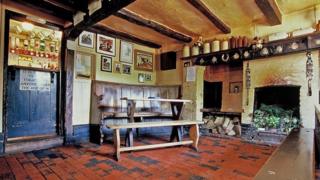 Image copyright
Image copyright
Michael Slaughter
The Blue Ship is one of eight pubs known to not have a bar counter with drinks instead served from a hatch
Other pubs without a bar to have their status updated include the Grade II Square and Compass in Worth Matravers, Dorset, and the Rose and Crown in Huish Episcopi and Tucker’s Grave Inn in Radstock, both Somerset.
 Image copyright
Image copyright
Michael Slaughter
The Rose and Crown dates from around 1800
Two Grade II pubs in London to have their status updated include the Hand and Shears in Middle Street, Smithfield, which retains original features and the Coach and Horses on Greek Street, Soho, which was famous for being the haunt of celebrated names such as Francis Bacon, Lucien Freud, Peter O’Toole and John Hurt, and as a meeting place for The Spectator and Private Eye magazines.
 Image copyright
Image copyright
Michael Slaughter
The Coach and Horses has been a favourite of famous faces from the arts and theatre world
The Grade II* Haunch of Venison in the centre of Salisbury, Wiltshire, began as a church house in the 1400s before becoming a public house.
It retains many of the features installed in a 1909 refurbishment including divided drinking spaces and a small ladies snug.
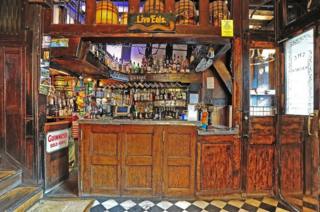 Image copyright
Image copyright
Michael Slaughter
The Haunch of Venison dates from the 15th Century
The Grade II Red Lion in Rugeley, Staffordshire, is one of the last surviving 17th Century buildings on what was once a busy commercial street and retains an unusual salt safe and inter-war interior including panelling and fireplaces.
 Image copyright
Image copyright
Geoff Brandwood
The Red Lion began as a house in the 1600s
Duncan Wilson, chief executive of Historic England, said: “English pubs are some of our best-loved community buildings and are often threatened with closure so we are delighted to see 11 historic pubs receiving further protection.”
The listings have been made by the Department for Digital, Culture, Media and Sport on the advice of Historic England.
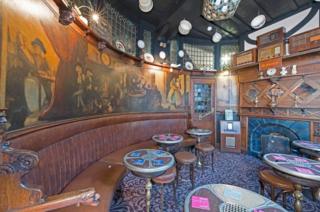 Image copyright
Image copyright
Michael Slaughter
Peter Kavanagh’s in Liverpool is named after its landlord and designer
The list of pubs was proposed by the Campaign for Real Ale (Camra) Pub Heritage Group, part of an ongoing collaboration between Historic England and Camra to protect historic pubs and their interiors.
Paul Ainsworth, chairman of the heritage group, said: “So few of England’s 40,500 pubs retain interiors which have not suffered major alterations over the years.
“Camra has identified 280 pubs whose interiors it considers to be of national historic importance, and we feel it is vital for these precious survivors to be preserved for future generations to enjoy.”
.
